Heian Period › The Portland Vase » Origins and History
Articles and Definitions › Contents
- Heian Period › Ancient History
- The Portland Vase › Antique Origins
Ancient civilizations › Historical places, and their characters
Heian Period › Ancient History
Definition and Origins

The Heian Period of Japanese history covers 794 to 1185 CE and saw a great flourishing in Japanese culture from literatureto paintings. Government and its administration came to be dominated by the Fujiwara clan who eventually were challenged by the Minamoto and Taira clans. The period, named after the capital Heiankyo, closes with the Genpei War in which the Minamoto were victorious and their leader Yoritomo established the Kamakura Shogunate.
FROM NARA TO HEIANKYO
During the Nara Period (710-794 CE) the Japanese imperial court was beset by internal conflicts motivated by the aristocracy battling each other for favours and positions and an excessive influence on policy from Buddhist sects whose temples were dotted around the capital. Eventually, the situation resulted in Emperor Kammu (r. 781-806 CE) moving the capital from Nara to (briefly) Nagaokakyo and then to Heiankyo in 794 CE to start afresh and release the government from corruption and Buddhist influence. This marked the beginning of the Heian Period which would last into the 12th century CE.
The new capital, Heiankyo, meaning 'the capital of peace and tranquillity,' was laid out on a regular grid plan. The city had a wide central avenue which dissected the eastern and western quarters. Architecture followed Chinese models with most buildings for public administration having crimson columns supporting green tiled roofs. Private homes were much more modest and had thatch or bark roofs. The aristocracy had palaces with their own carefully landscaped gardens and a large pleasure park was built south of the royal palace (Daidairi). No Buddhist temples were permitted in the central part of the city and artisan quarters developed with workshops for artists, metal workers and potters.
KYOTO WOULD REMAIN THE CAPITAL OF JAPAN FOR A THOUSAND YEARS.
No Heian Period buildings survive today from the capital except the Shishin-den (Audience Hall) which was burnt down but faithfully reconstructed and the Daigoku-den (Hall of State) which suffered a similar fate and was rebuilt on a smaller scale at the Heian Shrine. From the 11th century CE the city's longtime informal name meaning simply 'the capital city' was officially adopted: Kyoto. It would remain the capital of Japan for a thousand years.
HEIAN GOVERNMENT
Kyoto was the centre of a government which consisted of the emperor, his high ministers, a council of state and eight ministries which, with the help of an extensive bureaucracy, ruled over some 7,000,000 people spread over 68 provinces, each ruled by a regional governor and further divided into eight or nine districts. In wider Japan, the lot of the peasantry was not quite so rosy as the aesthetics-preoccupied nobility at court. The vast majority of Japan's population worked the land, either for themselves or the estates of others, and they were burdened by banditry and excessive taxation. Rebellions such as occurred in Kanto under the leadership of Taira no Masakado between 935 and 940 CE were not uncommon.

Model of Kyoto
The policy of distributing public lands which had been instigated in previous centuries came to an end by the 10th century CE, and the result was that the proportion of land held in private hands gradually increased. By the 12th century CE 50% of land was held in private estates ( shoen ) and many of these, given special dispensation through favours or due to religious reasons, were exempt from paying tax. This situation would cause a serious dent in the state's finances. Wealthy landowners were able to reclaim new land and develop it, thus increasing their wealth and opening an ever wider gap between the haves and have-nots. There were also practical political repercussions as the large estate owners became more remote from the land they owned, many of them actually residing at court in Heiankyo. This meant that estates were managed by subordinates who sought to increase their own power, and conversely, the nobility and the emperor became more separated from everyday life. Most commoners' contact with the central authority was limited to paying the local tax collector and brushes with the metropolitan police force which not only maintained public order but also tried and sentenced criminals.
MANY FUJIWARA STATESMEN WOULD ACT AS REGENT FOR THREE OR FOUR EMPERORS DURING THEIR CAREER.
The dominance of the Fujiwara was not total and did not go unchallenged. Emperor Shirakawa (r. 1073-1087 CE) attempted to assert his independence from the Fujiwara by abdicating in 1087 CE and allowing his son Horikawa to reign under his supervision. This strategy of 'retired' emperors, still in effect governing, became known as 'cloistered government' ( insei ) as the emperor usually remained behind closed doors in a monastery. It added another wheel to the already complex machine of government.
Back in the provinces, new power-brokers were emerging. Left to their own devices and fuelled by blood from the minor nobility produced by the process of dynastic shedding (when an emperor or aristocrat had too many children they were removed from the line of inheritance), two important groups evolved, the Minamoto (aka Genji) and Taira (aka Heike) clans.With their own private armies of samurai, they became important instruments in the hands of rival members of the Fujiwara clan's internal power struggle which broke out in the 1156 CE Hogen Disturbance and the 1160 CE Heiji Disturbance.
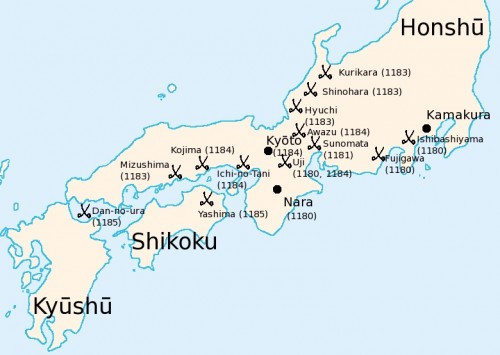
Battles of the Genpei War
The Taira, led by Taira no Kiyomori, eventually swept away all rivals and dominated government for two decades. However, in the Genpei War (1180-1185), the Minamoto returned victorious, and at the war's finale, the Battle of Dannoura, the Taira leader, Tomamori, and the young emperor Antoku committed suicide. The Minamoto clan leader Yoritomo was shortly after given the title of shogun by the emperor and his rule would usher in the Kamakura Period (1185-1333 CE), also known as the Kamakura Shogunate, when Japanese government became dominated by the military.
HEIAN RELIGION
In terms of religion, Buddhism continued its dominance, helped by such noted scholar monks as Kukai (774-835 CE) and Saicho (767-822 CE), who founded the Shingon and Tendai Buddhist sects respectively. They brought from their visits to China new ideas, practices, and texts, notably the Lotus Sutra ( Hokke-kyo ) which contained the new message that there were many different but equally valid ways to enlightenment. There was also Amida (Amitabha), the Buddha of Pure Land Buddhism, who could help his followers on this difficult path.
Buddhism's spread was assisted by government patronage, although, the emperor was wary of undue power amongst the Buddhist clergy and so took to appointing abbots and confining monks to their monasteries. Buddhist sects had become powerful political entities and although monks were forbidden from carrying weapons and killing, they could pay novice monks and mercenaries to do their fighting for them to win power and influence in the mishmash of nobles, landed-estate managers, private and imperial armies, emperor and ex-emperors, pirates, and warring clans that plagued the Heian political landscape.
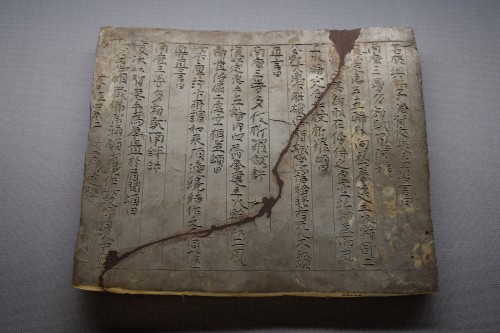
Sutra Inscribed Tablet
Confucian and Taoist principles also continued to be influential in the centralised administration, and the old Shinto and animist beliefs continued, as before, to hold sway over the general populace while Shinto temples such as the Ise Grande Shrine remained important places of pilgrimage. All of these faiths were practised side by side, very often by the same individuals, from the emperor to the humblest farmer.
RELATIONS WITH CHINA
Following a final embassy to the Tang court in 838 CE, there were no longer formal diplomatic relations with China as Japan became somewhat isolationist without any necessity to defend its borders or embark on territorial conquest. However, sporadic trade and cultural exchanges continued with China, as before. Goods imported from China included medicines, worked silk fabrics, ceramics, weapons, armour, and musical instruments, while Japan sent in return pearls, gold dust, amber, raw silk, and gilt lacquerware.
Monks, scholars, musicians, and artists were sent to see what they could learn from the more advanced culture of China and bring back new ideas on anything from painting to medicine. Students also went, many spending several years studying Chinese administrative practices and bringing back their knowledge to the court. Books came too, a catalogue dating to 891 CE lists more than 1,700 Chinese titles made available in Japan which cover history, poetry, court protocols, medicine, laws, and Confucian classics. Still, despite these exchanges, the lack of regular missions between the two states from the 10th century CE meant that the Heian Period overall saw a diminishing in the influence of Chinese culture, which meant that Japanese culture began to find its own unique path of development.
HEIAN CULTURE
The Heian period is noted for its cultural achievements, at least at the imperial court. These include the creation of a Japanese writing ( kana ) using Chinese characters, mostly phonetically, which permitted the production of the world's first novel, the Tale of Genji by Murasaki Shikibu (c. 1020 CE), and several noted diaries ( nikki ) written by court ladies, including The Pillow Book by Sei Shonagon which she completed c. 1002 CE. Other famous works of the period are the Izumi Shikibu Diary, Fujiwara no Michitsuna's Kagero nikki , and a Tale of Flowering Fortunes by Akazome Emon.
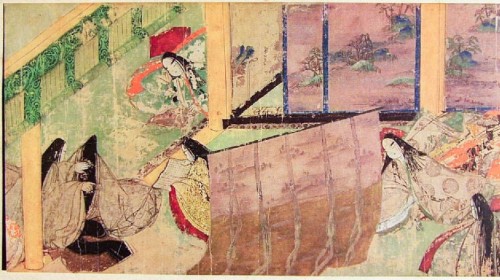
Tale of Genji Illustration
Men did write poetry, though, and the first anthology of royally commissioned Japanese poems, the Kokinshu ('Collection of the Past and Present') appeared in 905 CE. It was a collection of poems by men and women and was compiled by Ki no Tsurayuki, who famously stated, "The seeds of Japanese poetry lie in the human heart" (Ebrey, 199).
Besides literature, the period also saw the production of especially fine clothing at the royal court, using silk and Chinese brocades. Visual arts were represented by screen paintings, intricate hand scrolls of pictures and text ( e-maki ), and fine calligraphy. An aristocrat's reputation was built not only on his position at court or in the administration but also his appreciation of these things and his ability to compose his own poetry, play music, dance, master board games like go, and perform feats of archery.
Painters and sculptors continued to use Buddhism as their inspiration to produce wooden sculptures (painted or left natural), paintings of scholars, gilded bronze bells, rock-cut sculptures of Buddha, ornate bronze mirrors, and lacquered cases for sutras which all helped spread the new sects' imagery around Japan. Such was the demand for art that for the first time a class of professional artists arose, the work previously having been created by scholar monks. Painting also became a fashionable pastime for the aristocracy.
Gradually, a more wholly-Japanese approach expanded the range of subject matter in art. A Japanese style, Yamato-e, developed in painting particularly, which distinguished it from Chinese works. It is characterised by more angular lines, the use of brighter colours, and greater decorative details. Lifelike portraits of court personalities such as those by Fujiwara Takanobu, illustrations inspired by Japanese literature, and landscapes became popular, paving the way for the great works to come in the medieval period.
This article was made possible with generous support from the Great Britain Sasakawa Foundation.
The Portland Vase › Antique Origins
Ancient Civilizations
The Portland Vase is a Roman two-handled glass amphora dating to between the second half of the 1st century BCE and the early 1st century CE. The vase has a cameo-like effect decoration which perhaps depicts the marriage of Peleus and Thetis from Greek Mythology. After a long history of changes in ownership, disaster struck in 1845 CE when the vase was smashed to pieces in the British Museum. Fortunately, it has since been painstakingly restored so that it can once more take its rightful place amongst the very finest masterpieces of Roman art.
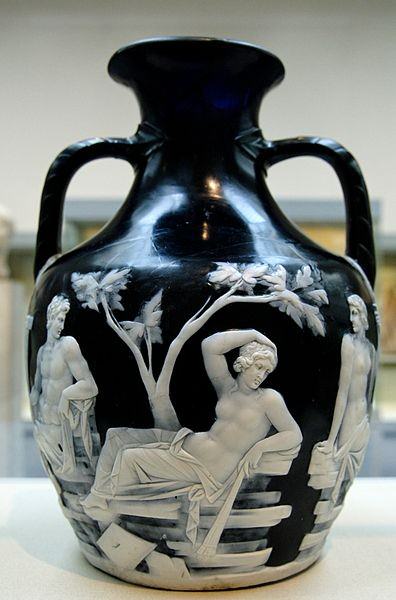
Portland Vase
PROPERTIES
The vase is 24.5 cm in height and 17.7 cm in its maximum width. The vase was made by blowing the dark cobalt blue coloured glass covered with a layer of opaque white cased glass. Large areas of the white glass were then removed to reveal the under layer of blue. Areas of white were left and carved in relief to depict scenes. The style of the decoration has led scholars to date the piece to the reign of Augustus (27 BCE - 14 CE). The fineness of detail of the decorative scenes is comparable to the highest quality Roman cut-gems and so it must be the work of a superbly talented gem-cutter or diatretarius.
The two-handled amphora vase is incomplete as it has lost its pointed base and the mouth of the vessel is curiously uneven in cut. The base was repaired using a similar coloured disk carved in the same style and depicting Paris. Although it is remarkable that such a delicate object has survived at all from antiquity, the vase is not unique, as a similar type vase has been found at Pompeii which dates to the mid-1st century CE and depicts scenes from a grape harvest. However, these cameo-cut vessels are regarded as something of an experiment in Roman glassware, carried out in a limited period spanning just two generations, so they were almost certainly not commonly produced.
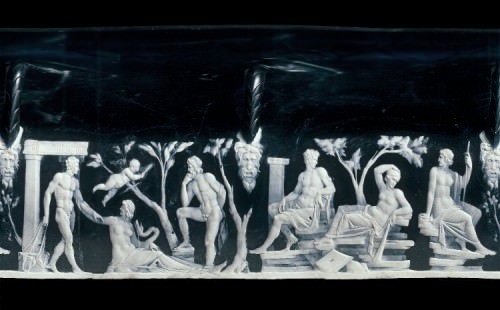
Portland Vase Scene Panorama
DECORATIVE SCENES
The scenes on the vase are divided into two parts by a bearded head (perhaps with horns), one under each handle. The first scene has four figures which include a young man leaving a shrine in the countryside and wearing a cloak. The man holds the arm of a semi-naked woman sitting on the ground preoccupied with stroking an animal resembling a snake. Above the woman is the flying figure of Eros with his customary bow and a torch in his right hand. On the right is a bearded male standing between two trees and depicted in a contemplative mood with his chin resting on his hand.
The second scene on the other side of the vase shows three figures all sitting on rocks with a background of a single tree. On the left is a young male next to a column or pillar, whilst in the centre is a young woman with her arm raised to her head and holding a torch which hangs down to the ground. On the far right is another half-dressed woman who holds a sceptre or staff in her left hand.
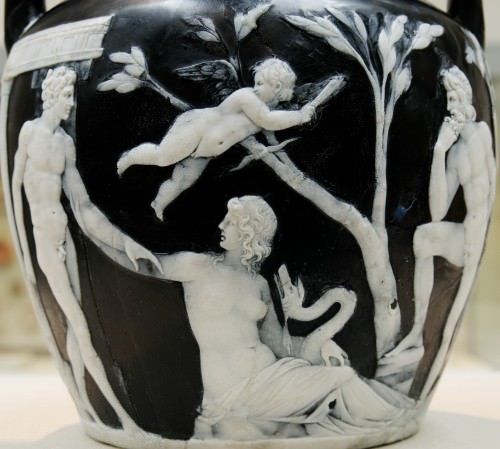
Portland Vase (Detail)
The exact significance of the scenes is not know for certain, but a commonly held speculation is that it is the wedding of Thetis and Peleus from Greek mythology that is being shown. Other interpretations include the dreams of Olympias, Alexander the Great 's mother. This would make the reclining female figures in both scenes Olympias, the snake Alexander 's father Zeus, and the young male leaving the temple as Alexander. Another interpretation is the similar story of Julia Mammaea and Roman emperor Alexander Severus. Finally, some have suggested the scene with Eros shows Mark Antony and Cleopatra, whilst the reverse scene has Augustus consoling Octavia with the goddess Venus looking on.
LATER HISTORY
The vase was discovered in a funerary monument in Rome in the 16th century CE and was initially believed to have come from a marble sarcophagus containing the remains of Alexander Severus - a claim now considered erroneous. The vase has almost certainly been polished since its original discovery and the scenes perhaps even reworked. After changing owners several times - amongst them the Barberini family whose name became attached to the vase - it was acquired by the Duchess of Portland in 1784 CE, a noted collector of antiquities. The vase has always been famous, but it became even more so from 1786 CE when Josiah Wedgwood made several copies of it in black and then lighter blue jasper-ware. In 1810 CE the 4th Duke of Portland loaned the vase to the British Museum in London for permanent exhibition.
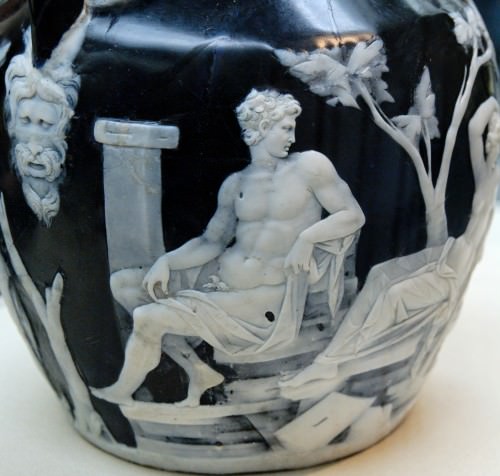
Portland Vase (Detail)
Seemingly now safe for all time, the Portland Vase was, however, to suffer one final twist of fate when in 1845 CE a drunken paranoia-suffering visitor to the museum inexplicably took a sculpted stone exhibit and threw it at the glass cabinet containing the vase. The vessel was smashed into well over 80 pieces. An immediate restoration was undertaken by John Doubleday and the incident served only to increase the vase's already considerable mystique and fame. The British Museum bought the vase outright in 1945 CE and it has since been dismantled and restored a further two times, the last in 1989 CE.
LICENSE:
Article based on information obtained from these sources:with permission from the Website Ancient History Encyclopedia
Content is available under License Creative Commons: Attribution-NonCommercial-ShareAlike 3.0 Unported. CC-BY-NC-SA License